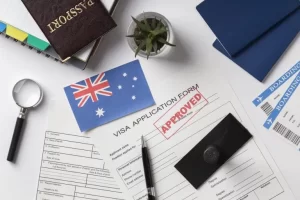Relationships can be hard. Making a match is hard…just think of marriage; 50% in Australia fail! Recruitment is building a work relationship. And building a work relationship with someone from another culture is even harder.
Expanding your workforce internationally can be a strategic move for your company, However, the process of hiring internationally comes with its own set of challenges and considerations.
To help you navigate this process seamlessly, we’ve compiled the ultimate checklist for regional employers looking to hire internationally. Each stage of the process should be complete before you enter the next stage- this will save you time and money and mitigate your risk of a dud candidate or visa refusal.
- Benchmark the Position
For a company to hire an international employee, certain skill and experience boxes to be ticked. For most employer sponsored visas the occupation you are hiring for needs to be listed on the Department of Home Affairs skilled occupation lists. For example Fitter-Welder is on the Medium and Long-term Strategic Skills List (MLTSSL), Factory Process Worker is not on any of the DoHA skilled occupation lists.
The link to the Skilled Occupation Lists can be found in our ultimate checklist resource.
If you can’t find the occupation you need there are other solutions that may be tailor made. Book an appointment to discuss a bespoke strategy.
- Attract International Applications
To attract international talent, advertise the position on various platforms such as Facebook, LinkedIn, and international job sites. Use paid adverts to expand your reach. Consider the locations you want to target based on the industries and occupations prevalent in those areas (Chefs in the tourism hub of Dubai is a good example).
Make sure to highlight the benefits of your regional location. Many candidates are looking for a long term location to call home so a vibrant local community with access to schools can be very attractive to some applicants, not everyone wants the big cities! The job page of your company website is easy to navigate and clearly specify the position is open to international candidates with sponsored positions available.
- Organise Applications
Once applications start rolling in, ensure that each applicant provides a professional resume demonstrating relevant skills, industry experience, qualifications,. English language proficiency is important to consider at this point as an English language test is required for most sponsored visa applicants. Consider creating a separate email address or funnel specifically for international applications to streamline the process.
We like to see a minimum of three years of recent full time experience for an international candidate. Industry qualifications are great, but industry experience and a formal skills assessment may be accepted in lieu of qualification.
It’s really important to be clear that any candidate you are taking to the next stage is ready to migrate. This means emotionally, geographically and financially
- Round One Applicant Filter
Once you filtered your resumes and have a pool of suitable applicants, you will need to make sure that these applicants are able to evidence the industry experience they are claiming on their resumes. When we say ‘evidence’ we mean supporting documentation like payslips, bank statements and job reference letters. These should be equivalent to the years that they are claiming on their resume as eligible experience. This can be tricky for some candidates, especially if they are coming from a workplace that has paid them in cash.
- Round Two Applicant Filter
By now you should have a really good short list of applicants who you feel confident have got appropriate industry experience to do the job you need, and (with the right support) will be able to lodge a valid visa application. This is the stage where you apply some more scientific and measurable tests. your applicant may have to undertake a skills assessment, and they also may have to take an English language test. It’s at this stage that we send our applicants a behavioural test and a job suitability test. These are really useful tools to help maximise a positive outcome for the candidate and employer.
- Shortlisted Applicant Video Interview
Conduct video interviews with shortlisted candidates to assess their experience, technical skills, personality fit, motivations for migrating, commitment to the position, and company knowledge. It’s this stage of the process we start asking much more job specific technical questions. It’s a good idea to have a list of these questions pre-prepared with a candidate score sheet. This will help you compare your short list of applicants. Video interviews are sometimes challenging, But this is a really good opportunity to get to know your candidate. Don’t just ask questions about the position, make sure you ask questions that are personal to the candidate. Consider questions like what do you love to? What is important to you?
Encourage candidates to ask questions to gauge their interest and engagement.
- Post Interview
I sometimes like to have more than one person in a candidate interview, especially if it’s a video interview. This is because body language and non-verbal cues are harder to read over video. A debrief with a colleague or trusted consultant it’s a really good way to break down things you have learned about a candidate in an interview. Sometimes a second or third interview is required, if that’s what it takes to make the perfect match
Following the interviews, conduct technical skills tests, personality profile assessments, and background checks including criminal and medical history. Once a suitable candidate is identified, extend the job offer. The salary has to meet the minimum income threshold for skilled migrants.
- Migration Process
Now is the time to build your relationship with a registered migration agent. make sure your Registered Migration Agent is currently registered with the Office Of Migration Agents Registration Authority (OMARA). Work with a trusted Registered Migration Agent specialising in employer-sponsored visas to navigate the migration process smoothly.
There are three stages to hiring an international employee on a skilled sponsored visa. Each stage of the process needs to be approved before the next stage. this process can be quite document and paperwork heavy so make sure the Registered Migration Agent you’re working with is someone who understands the needs of your business.
Ensure all necessary paperwork is prepared, lodged, and granted for both the company nomination and candidate visa applications.
- Candidate Arrival
Once the visa is granted, assist the candidate with arrangements such as flights, accommodation, airport pick-up, tax file number, bank account, health insurance, and introduction to local amenities. Provide comprehensive onboarding and support during the initial weeks to ensure a smooth transition.
- Performance Review
Once the successful candidate has arrived in Australia the journey has just begun! Setting out clear expectations and regular performance reviews makes sure that everyone is travelling in the same direction- towards success.
By following our ultimate checklist, business owners and leaders can effectively navigate the process of hiring internationally.








